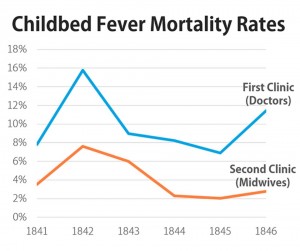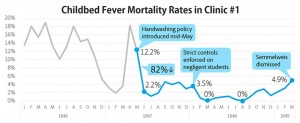Many of us misunderstand the word inspire. We think political leaders with a gift of the gab are inspirational but the word inspire actually means
To fill (someone) with the urge or ability to do or feel something, especially to do something creative.
So, if you communicate and it doesn't lead to an action, lack of inspiration could be the reason.
The question I want to answer in this blog is
Is it enough to have the insights from data to Inspire a desired action?
The answer is, No. Being inspired by data alone has been a problem for humanity long before we had access to tables, charts and graphs. While we may aspire to rely more on data in our decision-making, we rarely make decisions based on logical insights. Data Storytelling leads to the desired outcome.
Here is one illustrative example that I came across in one of Brent Dykes articles in Forbes
In 1846, Ignaz Semmelweis (1818-1865), a Hungarian doctor, was appointed as an assistant at a Vienna hospital with two maternity clinics for training doctors and midwives. Similar to other hospitals around the world at this time, many admitted mothers were dying of a mysterious illness called puerperal or childbed fever. Semmelweis discovered a disturbing trend where its doctors’ clinic had an average mortality rate of 9.9%, which was significantly higher than that of its midwives’ clinic (3.9%).
 Semmelweis was determined to identify the cause of this difference, but despite many considerations, he was not able to work out what the cause was. An unfortunate event triggered Semmelweis’ aha moment. When a close friend at the hospital was conducting an autopsy, he was accidentally poked by a student’s scalpel and later died from the wound. As Semmelweis performed the difficult post-mortem examination, he noticed a strong similarity in the pathology of his friend’s illness and that of the women who died of childbed fever.
Semmelweis was determined to identify the cause of this difference, but despite many considerations, he was not able to work out what the cause was. An unfortunate event triggered Semmelweis’ aha moment. When a close friend at the hospital was conducting an autopsy, he was accidentally poked by a student’s scalpel and later died from the wound. As Semmelweis performed the difficult post-mortem examination, he noticed a strong similarity in the pathology of his friend’s illness and that of the women who died of childbed fever.
At the Vienna hospital, it was common for the doctors to perform autopsies in the morning and then spend the rest of their day attending patients in the maternity ward—without ever washing their hands. Unlike the doctors, the midwives performed no autopsy work and were not in contact with any corpses. Semmelweis hypothesised that some kind of poisonous particles were being transferred by the doctors from the cadavers to the patients in the maternity clinic. He found a chlorinated lime solution was strong enough to remove the putrid smell of the autopsy tissue from the doctors’ hands and determined it would be ideal for removing these deadly contaminants.
As you can see from this story, having a great insight did not inspire the right action.
So, a relevant question to ask is, "What could have Semmelweis done differently and what can we learn from this?"
To find out click here
"I attended your story telling course some time back. And I've enjoyed keeping up my knowledge with your blog. You may not have realised however, that the Whole of Government is implementing Internet Seperation. Hence I'm not able to access the links to read your articles. Could I suggest including a QR code in your emails so that I can use my mobile to scan it and gain immediate access to the article? It would be most helpful"







